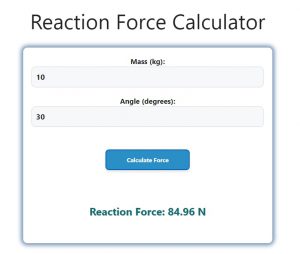About Reaction Force Calculator (Formula)
Reaction force is a fundamental concept in physics, particularly in mechanics, where it describes the force exerted by a surface in response to the weight of an object. This force is essential in understanding how objects interact with surfaces, such as the ground, inclined planes, or any supporting structure. The Reaction Force Calculator helps you determine the reaction force acting on an object based on its mass, the acceleration due to gravity, and the angle of the surface.
Formula
The formula to calculate the reaction force is:
F = m * g * cos(x)
Where:
- F is the reaction force.
- m is the mass of the object.
- g is the acceleration due to gravity (typically 9.8 m/s² on Earth).
- x is the angle of the surface relative to the horizontal.
How to Use
Using the Reaction Force Calculator is simple:
- Enter the Mass (m): Input the mass of the object in kilograms.
- Enter the Acceleration due to Gravity (g): Typically, this value is 9.8 m/s² on Earth.
- Enter the Angle (x): Provide the angle of the surface relative to the horizontal in degrees.
- Calculate: The calculator will instantly provide the reaction force acting on the object.
Example
Let’s say you have an object with the following characteristics:
- Mass (m): 10 kg
- Acceleration due to Gravity (g): 9.8 m/s²
- Angle (x): 30°
Using the formula:
F = 10 * 9.8 * cos(30°) ≈ 10 * 9.8 * 0.866 ≈ 84.87 N
The reaction force acting on the object is approximately 84.87 N (Newtons).

FAQs
- What is a reaction force?
A reaction force is the force exerted by a surface to support the weight of an object resting on it, in accordance with Newton’s third law of motion. - Why is the angle important in calculating reaction force?
The angle affects the component of gravitational force that acts perpendicular to the surface, thereby influencing the reaction force. - What units are used for reaction force?
The reaction force is typically measured in Newtons (N). - Can reaction force be zero?
Yes, reaction force can be zero if the object is not in contact with any surface, such as during free fall. - How does mass affect reaction force?
An increase in mass leads to a proportionate increase in the reaction force, assuming the angle and gravitational acceleration remain constant. - What role does gravity play in reaction force?
Gravity pulls the object towards the Earth, and the surface reacts with an equal and opposite force, calculated using the acceleration due to gravity. - What if the surface is horizontal?
If the surface is horizontal (angle x = 0°), the reaction force is simply equal to the weight of the object (m * g). - How does the angle of the surface influence the reaction force?
A steeper angle decreases the reaction force because the component of gravitational force perpendicular to the surface decreases. - Can this calculator be used for inclined planes?
Yes, this calculator is ideal for determining the reaction force on inclined planes. - What if the angle is 90 degrees?
If the angle is 90°, the reaction force is zero because the object would be perpendicular to the surface, resulting in no normal force. - Is reaction force the same as normal force?
Yes, in the context of mechanics, the reaction force is often referred to as the normal force, which acts perpendicular to the surface. - How do I calculate reaction force for non-standard gravitational fields?
Replace the standard gravitational acceleration (9.8 m/s²) with the appropriate value for the environment, such as the Moon or Mars. - What if multiple forces are acting on the object?
If multiple forces are acting, you would need to consider each force’s components and how they affect the net reaction force. - Does reaction force affect friction?
Yes, the reaction force influences friction since frictional force is proportional to the normal (reaction) force. - Can this calculator be used for objects on curved surfaces?
The calculator is designed for flat or inclined planes. Curved surfaces may require more complex calculations involving differential elements. - How does reaction force relate to stability?
Reaction force helps determine an object’s stability on a surface. Higher reaction forces generally indicate greater stability. - Can reaction force be calculated for floating objects?
Floating objects experience buoyant forces rather than reaction forces from a surface, so this calculator is not applicable in such cases. - Is the reaction force always vertical?
The reaction force is perpendicular to the surface, so on inclined planes, it is not purely vertical. - What happens if the surface is frictionless?
On a frictionless surface, the reaction force still exists and is calculated the same way, but there is no frictional force opposing motion. - How does reaction force apply to everyday scenarios?
Reaction force is present in everyday situations, such as standing on the ground or leaning against a wall, where surfaces provide the necessary support.
Conclusion
The Reaction Force Calculator is an essential tool for students, engineers, and physics enthusiasts, offering a quick and accurate way to calculate the reaction force acting on an object. By understanding how factors like mass, gravity, and angle influence this force, you can analyze and predict the behavior of objects on various surfaces, enhancing your knowledge of mechanics and applied physics. Use this calculator to simplify your calculations and gain deeper insights into the forces at play in everyday situations and complex engineering problems.